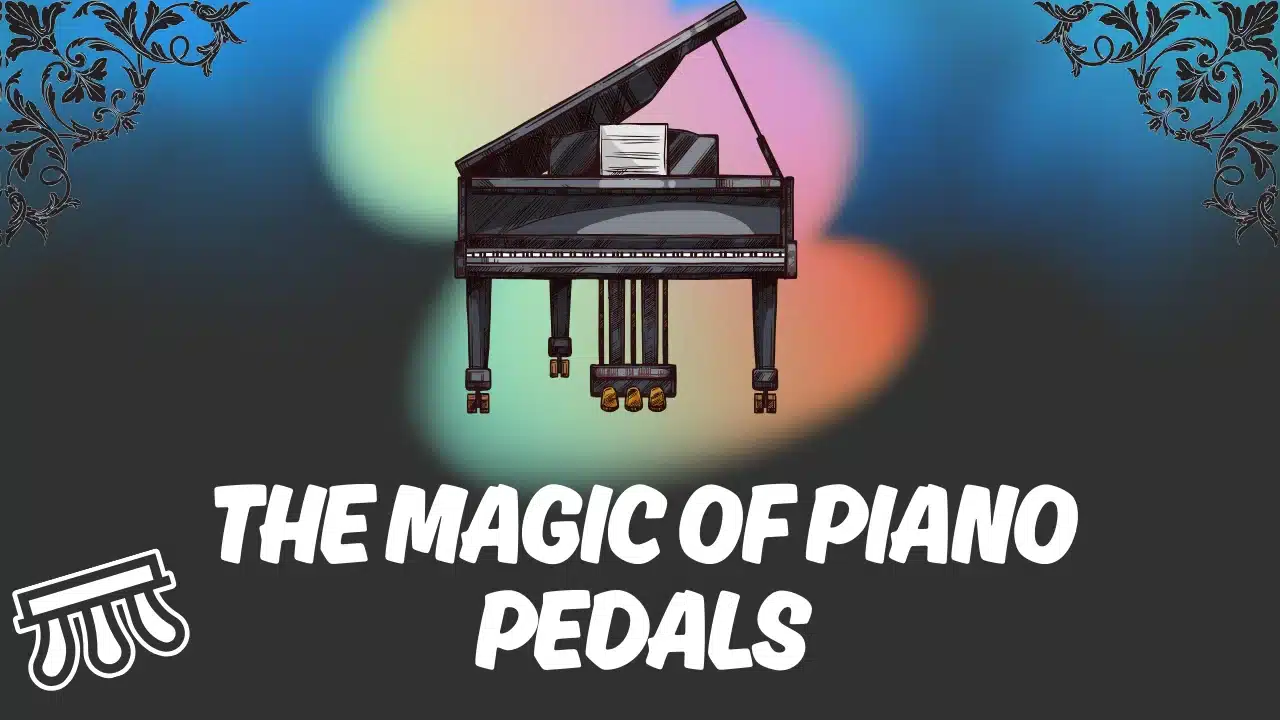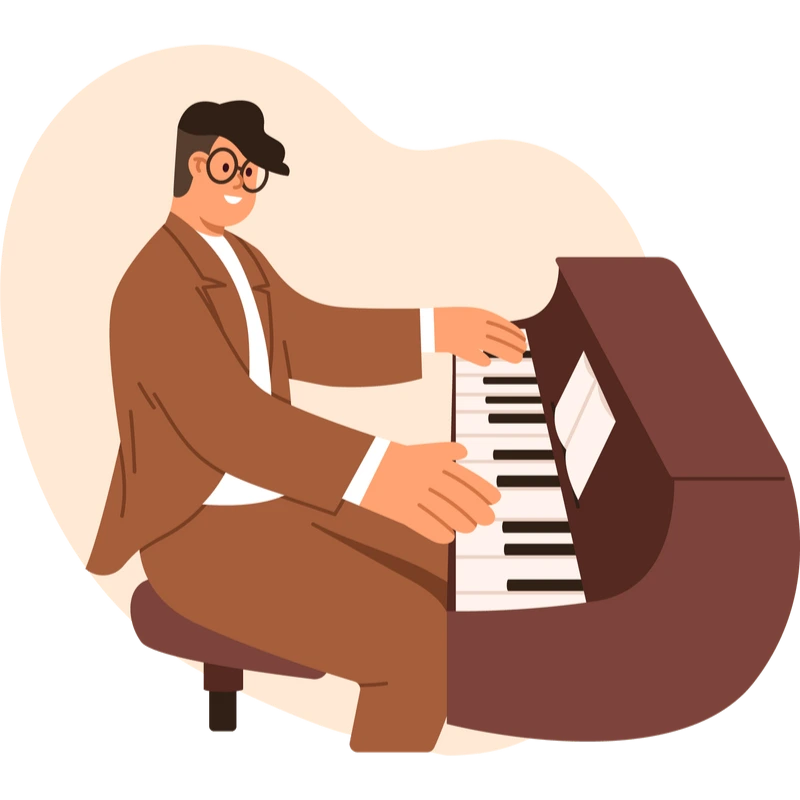- Introduction
- The Three Piano Pedals M
- The Damper Pedal (Right Pedal)
- When to Use the Sustain Pedal
- Sustain Pedal Techniques
- The Una Corda (Left Pedal)
- When to Utilize the Soft Pedal
- Soft Pedal in Grand vs. Upright Pianos
- Soft Pedal Techniques
- The Sostenuto Pedal (Middle Pedal)
- When to Use the Sostenuto Pedal
- Sostenuto Pedal in Upright vs. Grand Pianos
- Piano Practice Pedal
- How the Practice Pedal Works
- When to Use the Practice Pedal
- How to Use the Piano Practice Pedal
- Pedals on Digital Pianos
- Advanced Pedaling Techniques
- Common Pedal Mistakes
- How to Practice Pedal Techniques
- Piano Pedal Maintenance
- Best Piano Pedals
- Conclusion
- FAQs
When a piano player begins to play — it’s worth noting that the power of a pianist is all in their feet. The Damper makes the note ascend and Una Corda makes it whisper. The note may sing, but the pedal alone will make it soar — the music becomes an emotion at its finest. It concludes at the end that a piano’s soul lies in its pedals, influencing every uplifting sound.
Introduction
Only some pianists know how big the impact of the piano pedals is on the expressiveness of a musician. One of the greatest musical instruments that has changed as technology has evolved is the piano. They are a foot-activated contraption that changes the sound of the instrument in different ways. Most pianos have three pedals, but some models feature two or four. Every pedal has its function and is capable of creating the unique identity of the music being performed. In this blog, we will learn about the working and necessity of piano pedals.
The Oldest Pianos Had Knee Levers
Before pedals were placed at the pianist’s feet, some early pianos (like those from the 18th century) used knee levers instead of pedals. The levers were pushed by the knees to change the sound, and they were quite awkward to use!
The Three Piano Pedals M
Most pianos (grand and upright types) are equipped with three pedals. These are:
- Sustain or Damper Pedal
- Soft Pedal (aka) Una Corda
- Sostenuto Pedal
The Damper Pedal (Right Pedal)
This pedal is often referred to as the sustain pedal, and is the most frequently used pedal by many pianists whilst playing. When the pedal is pressed, it pulls all the dampers, allowing the strings to vibrate even after the key is released, so the sound is prolonged even more. By this way, they can create a smooth transition from one note to the other.
These pedals have different roles to perform and learning the role of these pads correctly gives you a better capacity for expressing emotions & music ideas more effectively.
When to Use the Sustain Pedal
Most often, you will find the sustain pedal in slower and more lyrical parts or when we are playing chords that need to be connected one after another so there are no little gaps between them. This will make your transition smoother & provide a touch of depth. Nevertheless, you should be careful with it and use it wisely because if overused, the music will sound chaotic.
Chopin and the Damper Pedal
Frédéric Chopin was a master at using the damper (sustain) pedal in his compositions. He revolutionized how the pedal was used, writing pieces that required very delicate and expressive use of the sustain to create his signature flowing, romantic sound.
Sustain Pedal Techniques
1. Synchronous pedal action: Push the pedal down right after you have played the note or chord, and let it go only after you play the second one. Thus you create a smooth sound that is collectively unified without intervaled harmonies.
2. Half-pedaling: This is a partial release of the pedal that lets some of the resonance pass through, though not all the way. It is an excellent way to take some of the sustain off and keep the sound clean.
3. Flutter pedaling: One can produce some effects by the quick throwing/letting of the pedal, especially in music of the impressionistic style.
The Una Corda (Left Pedal)
The una corda pedal is used to reduce the volume and alter the piano’s timbre. When this pedal is pressed, it limits the hammers to strike fewer strings, which produces a softer, more uniform and muted sound.
When to Utilize the Soft Pedal
The soft pedal is particularly well-suited for compositions that demand a delicate and more nuanced tone. It’s often used in quieter passages or when a subtle dynamic contrast is needed.
Soft Pedal in Grand vs. Upright Pianos
On a grand piano, the soft pedal adjusts the hammers to hit one string instead of three, which is why it’s called “una corda.” In contrast, on an upright piano, the soft pedal positions the hammers closer to the strings, reducing the impact of their strike. While both mechanisms achieve a softer sound, the effect is significantly more pronounced on a grand piano.
Soft Pedal Techniques
1. Utilize it conservatively: The function of the soft pedal is to create contrast between loud and soft or to increase the volume on very quiet passages.
2. Use it with dynamics: Consider the soft pedal with gentle/soft playing for more impactful results.
The Soft Pedal Revolution
In the early 19th century, the “una corda” (soft pedal) was considered a major innovation. When it was first introduced, it moved the hammers to hit only one of the three strings for each note, greatly softening the sound. Modern pianos still use this mechanism, though it now often shifts the hammer to hit two strings instead of three.
The Sostenuto Pedal (Middle Pedal)
This pedal, positioned in the center, is the least frequently employed. It sustains only the notes currently being played at the moment of depression, leaving any notes that follow unaltered. It’s particularly helpful for holding bass notes or specific chords while playing staccato or legato passages above them
When to Use the Sostenuto Pedal
This centrally positioned pedal is the least commonly utilized. It sustains only the notes played at the instant it is engaged, leaving any subsequent notes unaffected. For example, If you wish to sustain a chord in the lower register while your right hand plays freely, the Sostenuto pedal allows for this elegant possibility.
Sostenuto Pedal in Upright vs. Grand Pianos
While grand pianos have fully functional sostenuto pedals, many upright pianos lack them. Some uprights have a middle pedal, but it often functions differently (sometimes as a practice or mute pedal).
Sostenuto Pedal Technique
1. Pay all your attention to the correct timing of this action: It’s very important to press the sostenuto pedal immediately after playing the notes that you want to keep them sustained while you do not want them to keep the keys pressed at the end.
2. Start easy: It is a common thing to encounter difficulties with the sostenuto pedal when mastering the skill. It is best to start with easy exercises before advancing to more difficult ones.
Piano Practice Pedal
The piano practice pedal, also known as the mute pedal or practice mute, is a fantastic feature found on many upright pianos. Located in the center of the three pedals, it is designed to help pianists practice without producing a loud sound, making it ideal for late-night practice sessions or shared living spaces where noise could be an issue.
Note
Both the practice pedals and the sostenuto pedal cannot be utilized simultaneously, as only one is generally situated in the center of the three piano pedals.
How the Practice Pedal Works
When the practice pedal is engaged, a layer of felt is interposed between the hammers and the piano strings, effectively dampening the sound. This felt dampens the sound by softening the impact of the hammers on the strings, reducing the volume significantly. As a result, you can still hear the notes being played, but at a much quieter, muted level.
This pedal is especially useful for long practice sessions, allowing you to work on technique and fingerings, and even play full pieces without disturbing others.
When to Use the Practice Pedal
The practice pedal is mainly used in situations where full-volume piano playing isn’t possible or appropriate, such as:
- Practicing late at night
- Living in shared spaces or apartments
- Avoiding disturbing family members or neighbors
How to Use the Piano Practice Pedal
- Press the Practice Pedal: Step on the pedal to lower a felt layer between the hammers and strings, which softens the sound.
- Lock It (if available): Some pedals can be locked in place for continuous use by pressing and shifting them to the left.
- Play Quietly: With the pedal engaged, you can practice without disturbing others, though the tone will be muted.
It’s important to note that while the practice pedal is excellent for working on finger technique, it’s not ideal for practicing dynamics or tone quality since the muted sound doesn’t fully reflect the piano’s normal tone.
Pedals on Digital Pianos
Most digital pianos today come equipped with at least one pedal, and often, they include all three: sustain, soft, and sostenuto. Digital piano pedals aim to replicate the functions of acoustic pedals, but they achieve this electronically.
- Sustain Pedal on Digital Pianos: The sustain pedal on digital pianos works similarly to acoustic pianos but through electronic means. Some higher-end models even offer half-pedaling capability.
- Soft Pedal on Digital Pianos: While digital soft pedals don’t physically shift the hammers, they electronically reduce the volume and soften the tone.
- Sostenuto Pedal on Digital Pianos: Some digital pianos, especially more advanced models, come with a Sostenuto pedal. It functions similarly to an acoustic sostenuto pedal, though the effect might not be as nuanced.
- Practice Pedal on Digital Pianos: Some digital pianos have a similar feature, allowing players to control the volume electronically, often with a “quiet mode” that mimics the effect of the practice pedal. However, the concept is the same: reducing the sound level while maintaining the feel of piano playing.
Advanced Pedaling Techniques
Piano players who want to develop their skills, develop techniques, and learn to the fullest can go further in pedaling practice by these methods:
Layered Pedaling
It means applying the different pedals very quickly after one another, thus changing the sound several times in a very short time. For example, the combination of the soft pedal and half pedal of the damper pedal can lead to interesting tonal colors.
Rhythmic Pedaling
Rhythmic pedaling is the repetition of the pedal which sometimes appears as part of the sound as if it were a percussion instrument. On the other hand, this can lead to various visual effects.
Vibrato Pedaling
The method instructs one to push the damper pedal only slightly to make the shimmer/light wobble/vibrato.
Common Pedal Mistakes
Now that we’ve gone over the basics of each pedal, it’s important to address some common mistakes that pianists—especially beginners—often make when using the pedals.
1. Overuse of pedal: Many times musicians overuse the pedal and the result is a hazy, indistinct sound. You have to be pedaled with harmonic changes to keep the sound clear.
2. Under-pedaling: The insufficient use of pedal makes the music sound dry and separate. One has to be practical and use the pedal to make it a connected and legato sound at the right moment.
3. Improper pedal changes/random adjustments: Abrupt or unexpected changes can be unwanted breaks in the music. Among other things that a pianist needs to do when he/she wishes to change the timbre is to not only change the volume but also to play with another timbre.
4. Disregard the soft pedal: Many pianists ignore the soft pedal, which can lead to a lack of dynamic variety. The soft pedal allows for more delicate, intimate sounds, especially in pieces requiring subtle expression. Disregarding this pedal can make your performance less colorful.
5. Misuse of the sostenuto pedal: Incorrect usage of the sostenuto pedal, on the other hand, can create unintended sustained notes since the pedal will sustain all played notes at that time. Make sure you’ve made up your mind about which notes are supposed to be kept while you are still using the pedal before you start using it.
How to Practice Pedal Techniques
Mastering pedal use requires practice and patience. Here are some tips to improve your pedal technique:
- Try Half-Pedaling: Once you’re comfortable with full pedaling, experiment with half-pedaling to achieve more subtle sustain effects.
- Listen Carefully: Always be aware of how the pedals are affecting your sound. If things start to sound too blurry or muddy, try adjusting your pedal timing or using less pedal.
- Start Simple: When you’re just starting, use the sustain pedal with simple chord progressions to get a feel for how it works. Practice lifting the pedal at the right time to avoid overlapping sounds.
Beethoven Loved His Pedals
Beethoven was one of the first composers to write specific instructions on how and when to use pedals. He experimented with the damper pedal to create new textures and effects in his music, pushing the boundaries of what the piano could do.
Piano Pedal Maintenance
1. Regular Cleaning
- Dust Removal: Wipe pedals and surrounding areas with a soft, dry cloth to prevent dust buildup.
- Mild Cleaner: For stubborn dirt, use a slightly damp cloth with mild soap; avoid abrasive materials.
2. Check for Loose Parts
- Tighten Screws: Regularly check and tighten any loose screws to ensure smooth operation.
- Inspect for Wear: Look for signs of damage, like worn felt, and replace parts as needed.
3. Lubrication
- Hinges: If pedals feel stiff, apply a small amount of light oil or piano lubricant to hinges and mechanisms.
4. Humidity Control Stable Environment:
- Keep your piano in a stable environment to prevent damage to the pedals and overall instrument.
Best Piano Pedals
Here’s a table of the top 10 piano pedals from all four types—sustain, soft, sostenuto and practice pedals—along with their key features, pros, and cons:
| Pedal Model | Type | Key Features | Pros | Cons |
| Yamaha FC3A | Sustain Pedal | Half-pedal function, compatible with Yamaha digital pianos | Realistic feel, excellent durability | Limited compatibility with some brands |
| Korg DS-1H | Sustain Pedal | Half-damper capability, solid construction | Great for expressive playing | Pricier than basic models |
| Roland DP-10 | Sustain Pedal | Adjustable sensitivity, non-slip design | Durable, and versatile for various keyboards | May feel stiff for some players |
| M-Audio SP-2 | Sustain Pedal | Universal compatibility, robust design | Affordable, simple to use | Lacks advanced features |
| Yamaha LP1 | Soft Pedal | Designed for Yamaha digital pianos | Softens sound effectively | Not universally compatible |
| Korg DS-1 | Sostenuto Pedal | Compatible with many Korg keyboards, durable design | Allows selective sustain of notes | May require specific models for compatibility |
| Nektar NP-2 | Sustain Pedal | Universal compatibility, robust design | Good price-to-performance ratio | No half-damper capability |
| Korg PS-3 | Sustain Pedal | Compact design, compatible with Korg keyboards | Lightweight, portable | Basic functionality |
| Yamaha P-45 Practice Pedal | Practice Pedal | Built-in practice mode with adjustable volume | Great for quiet practice, user-friendly | Limited to specific models |
| Korg Padded Practice Pedal | Practice Pedal | Padded design for comfort and noise reduction | Reduces volume effectively | May require adjustment for the best results |
This is a table that shows some of the best piano pedals, categorized by type. Whether you’re a sustain pedal fanatic who wants the best pedal for expressive playing, or a soft pedal extraordinaire who just wants softer sounds, or even if you’re a sostenuto pedal guru or a practice pedal genius who likes to have quiet sessions, these selections offer very nice choices to improve you’re playing experience. All the pedals are different to accommodate different needs, so you can always find one that matches your piano.
Conclusion
All these pedals on a piano are integral to shaping, enriching, and elevating the depth and dynamics of your performance. Understanding the function of each pedal—the sustain, soft, and sostenuto—and learning when and how to use them will help you become a more expressive pianist. Whether you’re playing on a grand, upright, or digital piano, pedals offer endless possibilities for creating rich and nuanced sound. Practice using them wisely, and over time, they will become second nature, enabling you to explore the full range of musical expression.
FAQs
What do the piano pedals do?
The pedals on a piano offer the freedom to extend the duration of notes and cultivate their tone, thereby enhancing the instrument's expressiveness. The sustain pedal makes the notes last longer, the una corda pedal makes them softer, and the sostenuto pedal makes specific notes sustain while the others can be played normally.
How to use piano pedals?
Press the pedal just after striking a note for the sustain pedal, lift it before playing the next note to avoid muddiness, and use the soft pedal before playing to soften the sound. For the sostenuto pedal, engage it as needed by playing the desired notes and then pressing the pedal to sustain them while you proceed to play additional notes as usual.
What is a sustain pedal?
The sustain, or damper pedal, lifts the dampers from the strings, allowing the notes to resonate more freely and ring out with greater volume even after the keys have been released. It's essential for achieving legato and expressive playing.
What is a soft pedal?
The soft pedal, also known as una corda, enables the piano to produce a softer sound and generates a distinct, more tranquil tone by either causing the hammers to strike only a subset of strings or by positioning the hammers closer to the strings. It's useful for creating delicate, quiet passages.
What is a damper pedal?
Damper pedal, better known as the sustain pedal, serves the purpose of lifting the dampers so that the notes will sustain longer, and it adds a much fuller and richer sound.
How to maintain piano pedals?
Dust the pedals with a soft cloth often, look for loose screws, oil hinges if it needs it, and keep your piano in a relatively constantly humid environment to avoid excessive wear and tear.
What is a sostenuto pedal?
The sostenuto pedal sustains only the selected notes that are played while the pedal remains engaged. That way certain notes can continue to ring, yet other notes can be played without sustaining.
How to practice with piano pedals?
Connect notes using the sustain pedal for a legato sound. Practice lifting the pedal at the right moments to avoid muddiness, and experiment with the soft pedal for quieter passages to develop control over dynamics.
What are the different types of piano pedals?
There are three piano pedals namely,
- the sustain pedal (damper), which prolongs sound
- the soft pedal (una corda), which softens sound
- the sostenuto pedal, which selectively sustains notes
They also have practice pedals that silence the sound for practicing.


































